Bosnia journal 2023, Part 1: Srebrenica
I
arrived in Bosnia in late October, fresh from a four-week visit to Ukraine (see
my Ukraine journal
here). My previous experiences in Bosnia-Herzegovina had colored my view of
events in Ukraine. And my observations about wartime Ukraine resonated strongly
with my Bosnian friends. After all, these are people who had lived through their
own war.
I have changed the names of people in the following series of journals to
protect their privacy, unless they are public figures.
Mirsad and I talked a bit about Ukraine. He said, "There's not anything worse
than war. Not an earthquake, nothing. It's the worst thing people can do to each
other." Then, referring to the political situation in Bosnia, he said, "We're
always on the edge. It always seems like there could be a war. Last year (2022)
was particularly tense,
when Serbs were driving APCs around Brčko."
I said that rather than a buildup to war, it seemed to me like this was all a
kind of performance to make political points. But Mirsad did not agree.
Mirsad remarked that he would prefer that Bosnia just be a citizen's state with
one president, rather than an ethno-nationalist structure with a three-member
presidency. The president could be from any ethnicity, and he wouldn't care. He
added, "After all these years, we really should have been able to have a better
life by now. But we haven't been allowed to recover."
When I met my friend Tarik in the Krajina,
he called the war in Ukraine a
"copy-paste" of the Bosnia war. I mentioned my presentiment that by sometime in
2024, the unanimity of patriotism in Ukraine, and especially support for the
government, could dissipate in the face of a variety of behind-the-scenes
tensions, such as political disagreements, and especially corruption. That is
what happened in Bosnia.
And when I talked
to Senka about Ukraine, she said,
"It's too far
away for us to think about..."; Ukrainians had said the same thing to me about
conflicts going on in other parts of the world. Senka surprised me with her
understatement when, discussing the Ukraine war, said, "I don't know that I'd
want to be in another war."
What is taking place in Ukraine is not deja vu, and it is not history repeating
itself as farce. It is another manifestation of the dynamic where peripheral
countries, those situated between empires, suffer at the whim of Empire.
Ukraine's history, between Europe and Russia, resembles that of Bosnia, between
several empires over the centuries—although Bosnia has managed to preserve its
territorial continuity in one form or another consistently for a thousand years,
while Ukraine has not. There were many times, while in Ukraine, that I said
"It's Bosnia all over again." In both cases, it is for the citizens of each
country to resist aggression as well as they can—and for us to support them.
Making the rounds: Srebrenica

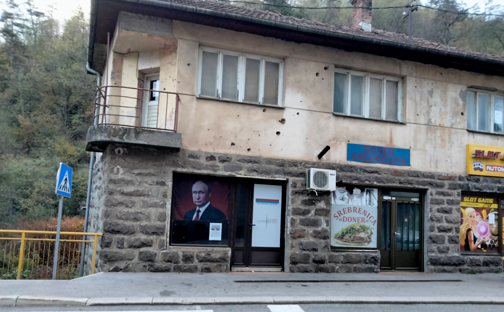
The main square upon arriving in the center of Srebrenica
The Srebrenica headquarters of "Istočna Alternativa"
I
traveled from Tuzla to Srebrenica, then to Sarajevo, and then on to Krajina in
the northwest. For a while I had the upsetting feeling that my ties to Bosnia
were weakening, as I found, especially in Tuzla and Srebrenica, that many of my
best friends and contacts had either died or moved away. The feeling was not
only on that personal level; for example, Srebrenica's postwar growth and its
dynamic, creative impulse have been in reverse for at least 15 years, with
people leaving for the city, or for other countries far away.
It did not improve my mood at all, as soon as I arrived at the center of town by
the supermarket, that I saw the storefront headquarters of
"Istočna
Alternativa" (Eastern Alternative) the band of provocateurs from Bratunac who
have been posting photos of the war criminals Šešelj and Mladić, along with
pictures of Putin, in Srebrenica—especially around the time of the July 11
anniversary of the fall of the enclave.
This time, in their shop window they had on display a photo of High
Representative Christian Schmidt, with the sarcastic message, "Appeal for help,"
calling on citizens
of the Republika Srpska to notify a psychiatric clinic if they spot Schmidt, who
they say is suffering from a "serious form of Serbo-phobia," as the poster puts
it.
It was good to read that Vojin Pavlović,
the ringleader of this outfit, has recently been indicted for "causing national,
racial, and religious hate, discord, and intolerance" by glorifying the memory
of the convicted war criminal Ratko Mladić, along with other similar deeds. As
one of his last acts before leaving the office in mid-2021, the previous High
Representative, Valentin Inzko, decreed a law outlawing the glorification of
convicted war criminals and denial of genocide in Srebrenica. The state
prosecutor has largely ignored this law, while RS President Dodik and others
regularly glorify everyone from Karadžić on down, so it will be interesting to
see what will happen with Pavlović.
I visited with Damir, an old friend and a sharp observer of things around
Srebrenica. He told me that in Srebrenica
there is precious little going
on in the once-active NGO world, and the present city government—run by a mayor
from Dodik's party, is the "worst ever." The social-democrat party exists, but
"you don't see anything of their activity." The Bosniak nationalist parties SDA
and NiP are there as well, but "they fight among themselves—just as the Serb
parties do."
Damir criticized the local government for a boondoggle project, building a
parking garage across the street from the supermarket, for a million KM.
Down
the street there had been a bakery, but it was closed the previous month
(October 2023). And on the door next to that bakery there is inscribed, as if on
a street sign, "Street of closed bakeries." photo Damir told me that the
municipality had encouraged the bakery to open by promising to pay a year's
rent. But, he said, it wasn't really a bakery; they bought bread from Bratunac
and sold it here. And they went out of business after 9 months, not being able
to compete with the supermarket right down the street, which imported the same
bread.
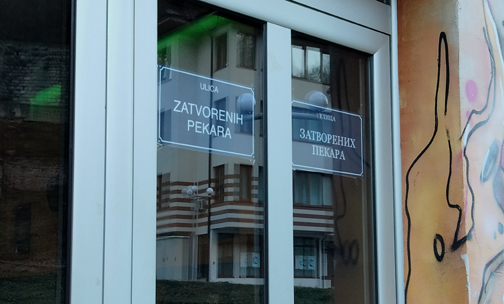
"Ulica zatvorenih pekara" -- Street of closed bakeries
There is
little or no economic development other than the parking garage. Damir says that
the government prevents the development of the Guber spa, which would enliven
the economy all around. Why? Twelve years ago there were already disputes about
ownership, (which I wrote about at length in my book). But my suspicion is that
this deadlock is maintained out of spite, to delay recovery until the last
Bosniak is gone.
I talked to my landlady.
She said that there is hardly any life in Srebrenica, which is the way it looked
to me. It was hard to walk around town, remembering how lively and cheerful it
was 20 years ago. That liveliness is hard even to imagine anymore. There used to
be many more kafanas and restaurants with people in them, having a good time.
There is a new report out that discusses the population trends in Srebrenica.
Before the war the municipality was home to nearly 37,000 people, according to
the 1991 census. During the war, while Srebrenica was maintained as a mainly
Bosniak enclave, first the Serb population left or was compelled to leave. Then
at the end of the war the Bosniaks—both those native to the municipality and
people seeking refuge from places as far away as Višegrad
and Vlasenica—were expelled or killed in the genocide.
At the height of return, say,
between 2002 and 2005, according to my own findings, the most realistic estimate
of return (and all were returnees, both Serb and Bosniak) was around 7,000 to
8,000.
Before the war Srebrenica was one of the most economically thriving
municipalities in Bosnia-Herzegovina, with strong tourism around the Guber spa,
and industries located in Potočari
and other suburbs. Afterwards all of that was devastated, and recovery has been
thwarted in various ways. In 1987 there were nearly 6,000 pupils in elementary
school, and today there are somewhat over 200.
[1]
The 2013 census counted over 13,400 residents of the municipality, but that
number was inflated. Today's (still inflated) number is around 11,000. But in
reality, there are more Srebrenicans in St. Louis than in Srebrenica; more in
Tuzla and Sarajevo than in Srebrenica, and for that matter, more resting in the
Potočari Memorial Cemetery as well.
I ran into Fahro, who lives near the center of town with his wife and three
children. I asked about what is happening with the Guber spa, what's keeping it
from being developed. He said "It's not in someone's interest," which is what
people often say when they don't know the answer to this kind of question.
People have never seemed to know exactly what is causing with that blockage. If
it were opened, it would set the whole region's economy alive.
Fahro talked to me about people who are leaving, the many who do not have
employment. He told me about a woman, a journalist at the local radio station,
who used the "G" word (genocide) and was reprimanded. She moved to central
Europe.
Fahro gave me a ride down to Potočari
to visit my friend Nermina,
where we sat for a
couple of hours and caught up. She doesn't have cows anymore; she sold them and
bought chickens, and is trying to sell eggs. It is just not economically viable
to raise cows for milk now, as the government buys a liter of milk for 45
pfennigs (about $0.30), and it costs more than that to feed the cows. And then
the government sells the milk for over 2.5 KM. And much of the milk here is
imported. It's been this way for a long time.
We talked about what is going on in Srebrenica. Nermina says that she prefers to
stay down on the farm, where life is simple. Near us, there was a man chopping
wood named Boško,
hired by Nermina. A local Serb, he is a neighbor and a friend.
When you have reasonable people
together, they can get along and live normally.
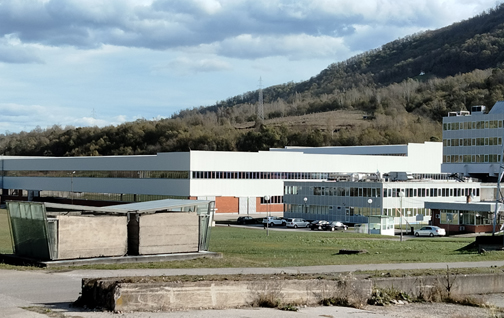
View of the former battery factory at Potočari,
refurbished into the Srebrenica Memorial Center
I went
to visit the Srebrenica Memorial Center in Potočari.
In the couple of years since I had last visited, the staff has done much work
updating and installing new exhibitions.
I sat and talked with Hasan
Hasanović for a
while. His father and twin brother Husein were killed in the war, and he made
the long hike for survival out of the enclave to safety. Now he works at the
Memorial Center, organizing interviews of survivors of the war.
Hasan showed me around. The Turkish government is financially supporting a large
exhibit in the great hall of the former battery factory. The US is supporting
the installation of unidentified artifacts in a back building, including exhumed
remains that have not been identified.
Hasan showed me the results of his project, an exhibit where about a hundred
people have donated mementos from the war, and artifacts from their loved ones
who were killed. In 1994, in the enclave, Hasan had written to his cousins in
Holland and given that letter to a UN soldier to deliver. But there was no
address. The soldier returned that letter to Hasan 23 years later. He has
donated it to the exhibit. Among other things, Hasan's handwritten letter talked
about going with his father and his uncle Hasan to cut firewood.
Each survivor who donated something also gave an oral statement about their lost
loved ones, and what the donated artifact meant to them. I sat and listened to
several of these recordings, from Hasan, Munira Subašić, Amra, and other people
whom I know. Amra was 13 in April of 1992, when her parents decided to send her
out of Srebrenica to Tuzla, to be safe. She saw her father crying as she left on
the last bus. She never saw him again. She donated his glasses and a watch,
which were found on her father's remains when they were discovered in 2008.
Munira Subašić,
leader of the Mothers of Srebrenica, donated the belt of her son. She talked
about how it had many new holes in it, as he had to make new ones as he was
losing weight in the enclave. And she donated the glasses of her husband Hilmo,
who had been a teacher. They found his remains in 2003. They only
found two bones of her son—in two different places.
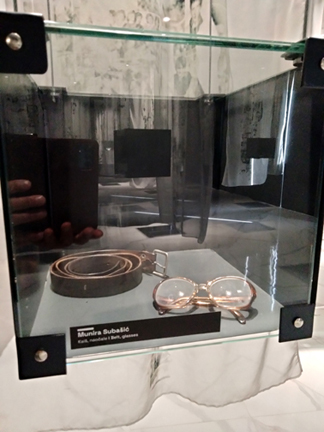
Munira
Subašić's
son's
belt
and
her
husband's
glasses
The artifacts and video testimonies are there to show that these
people once lived and are not forgotten.
I wondered, and doubted, whether there will ever be anything like this for those
who were being killed in Gaza as I wandered through Srebrenica.
Almasa, another worker at the museum, walked with me over to the big
exhibition hall. She commented that the figure of 8,372 genocide victims is not
real, since there were many people killed in the years before the fall of the
enclave—and many people who died of heartbreak afterwards.
Almasa showed me a list of men who were killed. Her brother, born in 1977, was
on the list. He would have been 18 when he was killed.
The exhibit is really more than I can stand to focus on for very long.
I said goodbye to Almasa, and walked across the street to the cemetery. I felt
struck by the fact that everyone I had talked with in the last couple of hours
had lost someone, or more than one person, in their immediate family, and they
have to live with that loss for the rest of their lives.
At the end of my visit to Srebrenica it was clear to me that the work at the
Memorial Center is probably by far the most dynamic and creative undertaking in
this city.
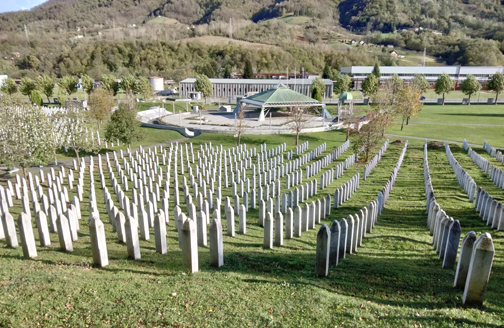
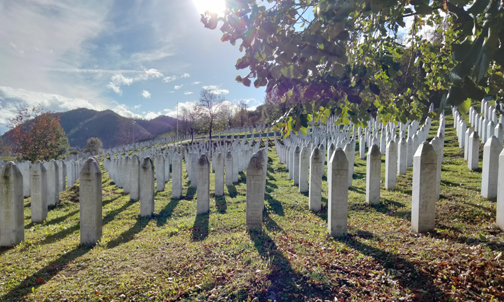
Views of the Memorial Cemetery
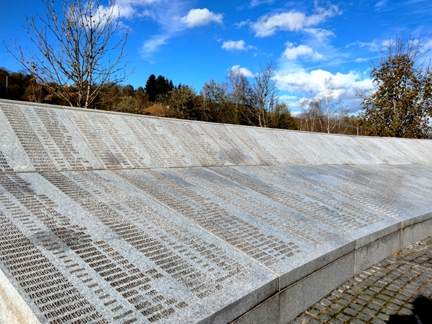
Part of the
wall listing the names of the genocide victims
*
[1] "Mjesto gdje se smijeh djece sve manje čuje" (A place where the
laughter of children is heard less and less), Sarajevo daily Oslobodjenje,
January 28, 2024.
Journal 1:
To Bosnia from Ukraine;
Visiting Srebrenica; Memorial Center
Journal 2: Sarajevo: Bistrik; Looking for Kazani
Journal 3: Gaza in Bosnia; Sevdalinka; Azra
Zornić
Journal 4: Krajina; More on Gaza;
Environmental Activism